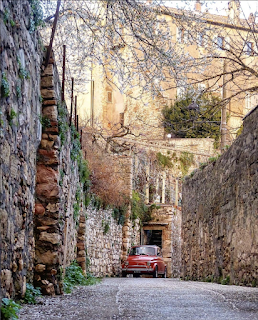 2024 Interdisciplinary Art Crime Conference,art crime,call for presenters,forgery,International Art Crime Conference,vandalism
2024 Interdisciplinary Art Crime Conference,art crime,call for presenters,forgery,International Art Crime Conference,vandalism
 No comments
No comments
2024 Amelia Conference - Save the Date and Call for Presenters
Collegio Boccarini (adjacent to the Museo Civico Archeologico e Pinacoteca Edilberto Rosa)
Held in the beautiful town of Amelia, Italy, the seat of ARCA’s summer-long Postgraduate Certificate Program in Art Crime and Cultural Heritage Protection, the Association’s 13th annual Amelia Conference will be held the weekend of June 21-23, 2024 with a networking cocktail opening the event for all conference participants.
At the heart of the conference will be two days of panel sessions, on Saturday and Sunday, June 22 and 23, 2024, devoted to presentations selected through this call. For more information about registering for this year's event, please see our link on the ARCA website here.
ARCA’s annual Amelia Conference serves as an arena for intellectual and professional exchange and highlights the nonprofit’s mission to facilitate a critical appraisal of the need for protection of art and heritage worldwide. Over the course of one weekend each summer, this art crime-focused event serves as a forum to explore the indispensable role of detection, crime prevention, and scholarly and criminal justice responses, at both the international and domestic level, in combatting all forms of crime related to art and the illicit trafficking of cultural property.Geared towards international organizations, national enforcement agencies, academics, cultural institutions, and private sector professionals in the art and antiquities fields, the Amelia Conference follows a long-established commitment by the Association to examine contemporary issues of common concern in an open, non-combative, multi-disciplinary format in order to promote greater awareness and understanding of the need for better protection of the world’s cultural patrimony.
2024 Call for Presenters: Session Formats and Topics
Given the success of the Amelia Conference over the past decade, it is important to recognise the growing interdisciplinary and international nature of this emerging field, the growing complexity of art and heritage crime, and the disciplines and subject matter experts who follow along and contribute within their areas of speciality. With that in mind, this year’s conference will build upon topic-specific sessions designed to stimulate discussion and share learning on a series of topics of common concern. Some conference panels may feature more active panel debate about a session topic, or present various and/or contrasting perspectives about a topic. Each panel session will last approximately 75 or 90 minutes and will include a number of oral presentations with some time dedicated for interactive discussion afterward.
ARCA welcomes presentation proposals related to the conference’s art and antiquities crime theme from individuals in relevant fields, including law, policing, security, art history, art authentication, archaeology, or the allied art market.
Presenters with topics related to the following areas are particularly encouraged to submit a speaking proposal this year highlighting the following issues of common concern:
Strengthening international cooperation in the fight against illicit trafficking. How have things changed in the last decade in terms of international cooperation?
Organised crime's footprint on and in art market trade and transactions.
Recent successes in the field and what we can learn from them collectively.
Peeling back the obstacles: Why is it so hard for museums to proactively address problematic art in their collections and enact restitutions once those problems have been identified.
Consciousness raising regarding vandalism as a form of climate or world issues protest in museums.
Digital and technology-facilitated approaches to combatting illicit trafficking.
Recent convictions: Art crime’s bad boys (and girls) and what we can learn from their prosecutions.
Recent hot topic and dramas in the field of forgery.
Resolving art disputes in and outside of the courtroom.
Each selected presenter will represent a coherent and clearly focused presentation of 15 to 20 minutes maximum on a topic of common concern, that combined with presentations given by co-panelists, are designed to provide significant insights into the topic or theme and to stimulate thoughtful, not combative or antagonistic, discourse.
We very much look forward to receiving presentation proposals on the aforementioned or alternative art and antiquities crime topics, noting that panels may change or be altered based on speaker availability.
Abstract and CV Submission Deadline: April 15, 2024
Abstract Word Limit: 400 words, excluding abstract title, presenter/co-presenter names and affiliations
Abstract Selection Process
Each submitted abstract must be accompanied by a CV. The abstract review process will be conducted blind, i.e. all author names will be removed before the abstract before being sent out for peer review. The abstract itself will be reviewed and scored by independent reviewers who have expertise in the specific session’s identified subject area.
Peer Reviewers apply the following criteria to judge abstract submissions
I. Quality and Originality (1 to 5)
Abstracts containing significant new findings or presenting concretised information or new approaches will be given higher scores than those that merely serve as a chronology of, or modifications to, older findings or routine topics of dischord.
II. Importance (1 to 5 pts)
This criterion addresses the importance of the presentation or research in terms of covering new ground and in advancing knowledge in the art crime and cultural heritage protection field.
III. Presentation (1 to 5 pts) This criterion addresses how well the specific research question(s) and objectives, methods used, primary results, facts ascertained, etc., are explained, rather than simply titling the topical subject itself. A clearly written abstract follows a logical order (e.g. aims, methods, outcome of investigation or analysis).
FINAL NOTE
All accepted participants are responsible for their own travel and accommodation expenses, however, accepted conference presenters will have their conference fees waived and will be invited to be ARCA’s guest for the Amelia Conference icebreaker cocktail on 21 June 2024.
































